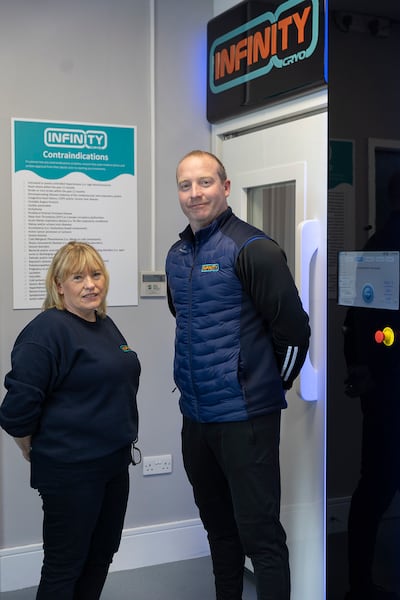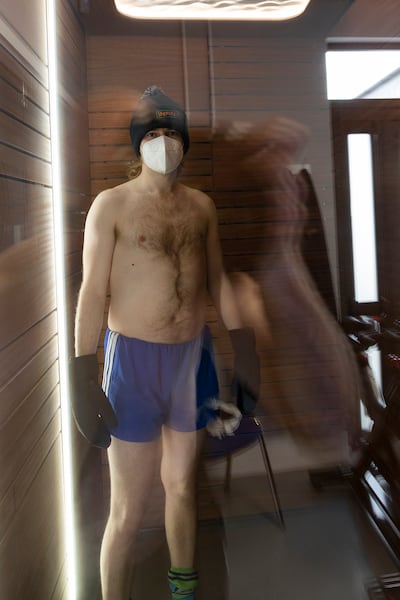Years back, John Connors suffered an injury that changed his life permanently – or so he thought.
“I got a bad belt in the head,” says the Thurles native (they don’t mess around on the pitch in Tipperary). “It was in 2008, before the helmets came in [as compulsory]. That’s how long ago I’m hurling.”
Three days in hospital later, he was discharged for what he hoped was the end of the affair. Then the migraines started. Years of medications did little to relieve his symptoms, until he discovered a surprise solution he now swears by – cryotherapy.
The treatment, which involves enduring exceptionally cold temperatures for a few minutes, was originally invented in Japan in the 1970s for rheumatoid arthritis, but has since increased in popularity for its supposed wider health benefits.
[ Feeling uncoordinated shouldn’t mean you can’t participate in sportsOpens in new window ]
Last March, Connors left his job as a strength and conditioning coach to join with his business partner Kathryn Cullen to set up Infinity Cryo in Thurles, with the hope of attracting people to what they claim is the most modern cryochamber model available in the world. If -60 degrees sounds difficult to endure for 30 seconds in the first chamber, you can imagine what -120 degrees for three minutes in the second chamber feels like.
That’s much colder than the lowest natural temperature ever recorded on Earth.

Walking into the facility, there’s that new-build smell, with high-tech machines dotted around the place. Infinity Cryo offers an infrared sauna, ice bath plunge pool, hot-tub and compression therapy, but the main attraction is, without doubt, the cryotherapy chamber.
“You would buy a small house for it in Dublin,” Connors says (as much as €320,000, he later adds). “No other machine in Ireland can reach -120 degrees.”
Three minutes never felt so long, much of which was spent wondering why penguins don’t move some place warmer
He uses the machine at least once every 10 days, which seems to stave off the migraines.
So how does it work?
Cullen, a former special needs assistant, explains: “You go in and the cold tricks your mind into sending out a distress signal to all your internal systems. It puts it on alert and makes it think it’s in danger. Your body then goes into protect mode and calls back all your blood to your core. As your blood rushes back to protect your vital organs, your treatment is over and your three minutes are up.”
Then users gently move on an exercise bike “to let your body know it’s not in danger anymore”, and it sends the blood back out: “It realises, ‘no, lads, we’re grand’.”
The process floods your blood with good hormones, builds protein, fills blood with oxygen – “all the fabulous stuff,” she says. “So as your blood is going back out, it’s taking all that with it around your body. It’s mending as it goes along. Your sleep patterns are better, your mind is calmer, so you sleep better, your mood is better the following day because you’ve had a good sleep. It’s all kind of a knock-on effect.”
‘This man wants me to suffer’
Connors recommends going in without a top on. “To get the full experience,” he says, though all I hear is: “This man wants me to suffer.”

I pull up my high socks, slip on some mittens reminiscent of Bernie Sanders at the Biden inauguration, and pull down a thick beanie over my head (I’m told about a cryotherapy chamber abroad where one unfortunate left a rogue dreadlock outside his hat which later snapped off).
The first chamber (-60 degrees for 30 seconds) felt baltic, but on plunging into a woosh of icy air and into the second chamber, things got serious. A supposedly helpful timer counted down on the wall, but paying attention only made it feel longer. All you can do is short breaths and movements side to side.
[ A 20-minute brisk walk can reduce risk of depression, study findsOpens in new window ]
Three minutes never felt so long, much of which was spent wondering why penguins don’t move some place warmer.
Finally, on exiting via the first chamber, it felt like a summer’s day in comparison. After 15 minutes slowly cycling on a bike (to get the blood circulating again) I went in for round two. And two was enough. My skin temperature had already plunged by 13 degrees.
Freshly stiff from a run a few days before, I certainly felt more energised in my body. I was assured I would sleep like a baby that night and feel destressed with less cortisol in my system, but as a heavy sleeper and generally stressless person, it was difficult to notice benefits on that end.
For a starting price of €50 for a session, cryotherapy is certainly an experience worth trying to combat any pressing ailments.
Whether you’re out on the pitch, or just looking to improve your overall wellbeing (Connors and Cullen are keen to get the word out for its mental health benefits), it’s worth embracing your inner penguin and giving it a go.
Even if it is ridiculously cold.











